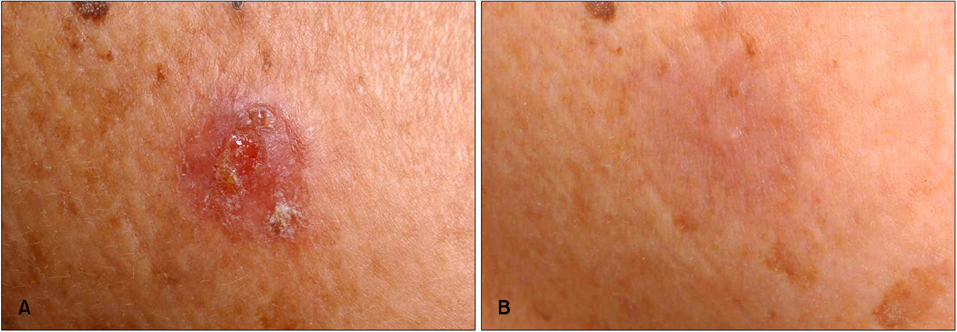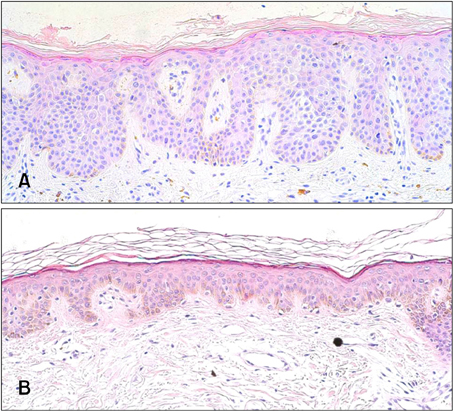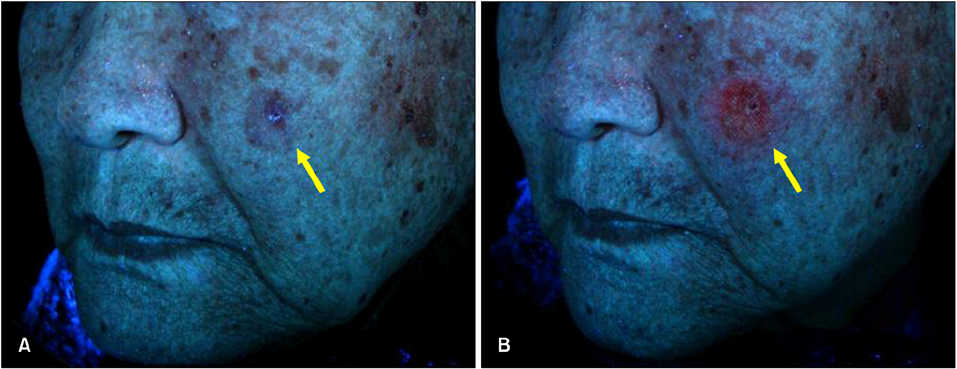Ann Dermatol.
2013 Aug;25(3):335-339. 10.5021/ad.2013.25.3.335.
Photodynamic Therapy with Ablative Carbon Dioxide Fractional Laser for Treating Bowen Disease
- Affiliations
-
- 1Department of Dermatology, Ajou University School of Medicine, Suwon, Korea. maychan@ajou.ac.kr
- 2Institute for Medical Sciences, Ajou University School of Medicine, Suwon, Korea.
- KMID: 2265874
- DOI: http://doi.org/10.5021/ad.2013.25.3.335
Abstract
- BACKGROUND
Topical photodynamic therapy (PDT) has been increasingly used to treat malignant skin tumors including the Bowen disease. However, patients could be displeased with the long incubation time required for conventional PDT.
OBJECTIVE
We evaluated the efficacy and safety of PDT with a short incubation time of ablative CO2 fractional laser pretreatment for treating Bowen disease.
METHODS
Ten patients were included. Just before applying the topical photosensitizer, all lesions were treated with ablative CO2 fractional laser, following the application of methyl aminolevulinate and irradiation with red light (Aktilite CL 128). Histological confirmation, rebiopsy, and clinical assessments were performed. Adverse events were also recorded.
RESULTS
Five of the ten (50%) lesions showed a complete response (CR) within three PDT sessions. After four treatment sessions, all lesions except one penile shaft lesion (90%) achieved clinical and histological CR or clinical CR only. The average number of treatments to CR was 3.70+/-1.70. The treatments showed favorable cosmetic outcomes and no serious adverse events.
CONCLUSION
The results suggest that pretreatment with an ablative fractional CO2 laser before PDT has similar treatment efficacy and requires a shorter photosensitizer incubation time compared with the conventional PDT method.
MeSH Terms
Figure
Cited by 1 articles
-
Photodynamic Therapy in Bowen Disease of the First Web Space of the Hand
Soo-Eun Jung, Sue Kyung Kim, You Chan Kim
Ann Dermatol. 2015;27(1):76-78. doi: 10.5021/ad.2015.27.1.76.
Reference
-
1. Morton CA, McKenna KE, Rhodes LE. British Association of Dermatologists Therapy Guidelines and Audit Subcommittee and the British Photodermatology Group. Guidelines for topical photodynamic therapy: update. Br J Dermatol. 2008; 159:1245–1266.
Article2. Morton C, Horn M, Leman J, Tack B, Bedane C, Tjioe M, et al. Comparison of topical methyl aminolevulinate photodynamic therapy with cryotherapy or Fluorouracil for treatment of squamous cell carcinoma in situ: results of a multicenter randomized trial. Arch Dermatol. 2006; 142:729–735.3. Gerritsen MJ, Smits T, Kleinpenning MM, van de Kerkhof PC, van Erp PE. Pretreatment to enhance protoporphyrin IX accumulation in photodynamic therapy. Dermatology. 2009; 218:193–202.
Article4. Fang JY, Lee WR, Shen SC, Fang YP, Hu CH. Enhancement of topical 5-aminolaevulinic acid delivery by erbium:YAG laser and microdermabrasion: a comparison with iontophoresis and electroporation. Br J Dermatol. 2004; 151:132–140.
Article5. Haedersdal M, Sakamoto FH, Farinelli WA, Doukas AG, Tam J, Anderson RR. Fractional CO(2) laser-assisted drug delivery. Lasers Surg Med. 2010; 42:113–122.
Article6. Lehmann P. Methyl aminolaevulinate-photodynamic therapy: a review of clinical trials in the treatment of actinic keratoses and nonmelanoma skin cancer. Br J Dermatol. 2007; 156:793–801.
Article7. Clementoni MT, B-Roscher M, Munavalli GS. Photodynamic photorejuvenation of the face with a combination of microneedling, red light, and broadband pulsed light. Lasers Surg Med. 2010; 42:150–159.
Article8. de Leeuw J, van der Beek N, Bjerring P, Neumann HA. Photodynamic therapy of acne vulgaris using 5-aminolevulinic acid 0.5% liposomal spray and intense pulsed light in combination with topical keratolytic agents. J Eur Acad Dermatol Venereol. 2010; 24:460–469.
Article9. Fang YP, Wu PC, Tsai YH, Huang YB. Physicochemical and safety evaluation of 5-aminolevulinic acid in novel liposomes as carrier for skin delivery. J Liposome Res. 2008; 18:31–45.
Article10. Smucler R, Vlk M. Combination of Er:YAG laser and photodynamic therapy in the treatment of nodular basal cell carcinoma. Lasers Surg Med. 2008; 40:153–158.
Article11. Forster B, Klein A, Szeimies RM, Maisch T. Penetration enhancement of two topical 5-aminolaevulinic acid formulations for photodynamic therapy by erbium:YAG laser ablation of the stratum corneum: continuous versus fractional ablation. Exp Dermatol. 2010; 19:806–812.
Article12. Fukui T, Watanabe D, Tamada Y, Matsumoto Y. Photodynamic therapy following carbon dioxide laser enhances efficacy in the treatment of extramammary Paget's disease. Acta Derm Venereol. 2009; 89:150–154.13. Haedersdal M, Katsnelson J, Sakamoto FH, Farinelli WA, Doukas AG, Tam J, et al. Enhanced uptake and photoactivation of topical methyl aminolevulinate after fractional CO2 laser pretreatment. Lasers Surg Med. 2011; 43:804–813.
Article14. Calzavara-Pinton PG, Venturini M, Sala R, Capezzera R, Parrinello G, Specchia C, et al. Methylaminolaevulinate-based photodynamic therapy of Bowen's disease and squamous cell carcinoma. Br J Dermatol. 2008; 159:137–144.
Article15. Cox NH, Eedy DJ, Morton CA. British Association of Dermatologists. Guidelines for management of Bowen's disease. Br J Dermatol. 1999; 141:633–641.
Article16. Cox NH, Eedy DJ, Morton CA. Therapy Guidelines and Audit Subcommittee, British Association of Dermatologists. Guidelines for management of Bowen's disease: 2006 update. Br J Dermatol. 2007; 156:11–21.
Article17. Varma S, Wilson H, Kurwa HA, Gambles B, Charman C, Pearse AD, et al. Bowen's disease, solar keratoses and superficial basal cell carcinomas treated by photodynamic therapy using a large-field incoherent light source. Br J Dermatol. 2001; 144:567–574.
Article18. Ho SG, Chan HH. The Asian dermatologic patient: review of common pigmentary disorders and cutaneous diseases. Am J Clin Dermatol. 2009; 10:153–168.19. Kim YC, Kim IH, Lee MG, Cho KH. Clinical efficacy and tolerance of Metvix®-photodynamic therapy in the treatment of actinic keratosis, basal cell carcinoma, and Bowen's disease in South Korea. Korean J Dermatol. 2008; 60:Suppl. 2. 108.20. Kim YJ, Kang HY, Lee ES, Kim YC. Photodynamic therapy for treatment of Bowen's disease. Korean J Dermatol. 2007; 45:237–241.21. España A, Solano T, Quintanilla E. Bleomycin in the treatment of keloids and hypertrophic scars by multiple needle punctures. Dermatol Surg. 2001; 27:23–27.
Article22. Borelli C, Herzinger T, Merk K, Berking C, Kunte C, Plewig G, et al. Effect of subcutaneous infiltration anesthesia on pain in photodynamic therapy: a controlled open pilot trial. Dermatol Surg. 2007; 33:314–318.
Article
- Full Text Links
- Actions
-
Cited
- CITED
-
- Close
- Share
- Similar articles
-
- A Case of Squamous Cell Carcinoma Treated with Photodynamic Therapy with Ablative Carbon Dioxide Fractional Laser
- A Case of Squamous Cell Carcinoma Treated with Photodynamic Therapy with Ablative Carbon Dioxide Fractional Laser
- Photodynamic Therapy with Ablative Carbon Dioxide Fractional Laser in Treatment of Actinic Keratosis
- Successful Treatment of Granuloma Annulare Using Ablative Fractional Carbon Dioxide Laser-Assisted Photodynamic Therapy
- Refractory Non-segmental Vitiligo Effectively Treated with Ablative Fractional Carbon Dioxide Laser




